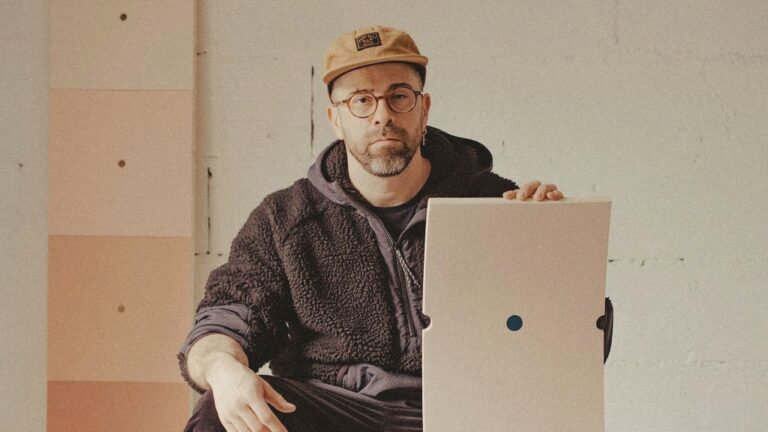
A Conversation with Alejandro Javaloyas
A Studio Visit During the La BIBI Residency
In 1970, the famous art historian Linda Nochlin finished writing what was about to be, arguably, the most crucial article of her career: “Why Have There Been No Great Women Artists?”[1] At the start of the following year, the essay featured in the publication Woman in Sexist Society: Studies in Power and Powerlessness before being revised – and slightly retitled – and published in the 1971 January issue of one of the most important contemporary art magazines in the world: ArtNews.
The iconic essay was praised internationally and highly for standing up and defending a feminist art history and theory, which would continue to influence the art world today. Her article was published during the strong rise of feminist activity in the art world and beyond. Nochlin discussed the ubiquitous presence of institutional obstacles for women to succeed as artists. She argues the notion of artistic genius remained bound to the male sex, resulting in no truly ‘great’ women artists.
Without reciting everything that has been said during the 70s – and beyond – when it comes to feminism in art and the actual Feminist Art movement, encompassing iconic artists and artworks such as The Guerrilla Girls’ famous poster Do Women Need To Be Naked to Get into the Met. Museum? up to Barbara Kruger’s I Shop Therefore I Am. Fifty years later, let’s revisit Linda Nochlin’s question: Have there been great women artists?
In our most recent survey presenting The Ultimate Top 100 Modern & Contemporary Artists, we were very curious from the start to see how many – and who – of the female artists would enter this list. The answer is 17. 17 out of 100 artists, encompassing the modern and contemporary era, are female. The survey has been completed using the Artfacts[2] algorithm, ranking artists based upon data such as objective career facts, for instance, the artist’s presence in institutional shows – exactly where the sticking point is, as Linda Nochlin pointed out in 1971.
Although 17 still is no equal 50 – or close to 50 – we must also point out the list also takes into account artists before 1971 from the modern era. Whereas our list presents almost only female artists whose careers have taken place after Nochlin’s article and in the contemporary era. Thus, with time, the balance continues to shift to an equal balance.
So, 50 years later, since ‘there have been no great women artists,’ it is my pleasure to present you 17 Great (with a capital G) female artists who have defined the contemporary era and the art world as we know it today. This is the top 17 most significant female artists of the contemporary era.
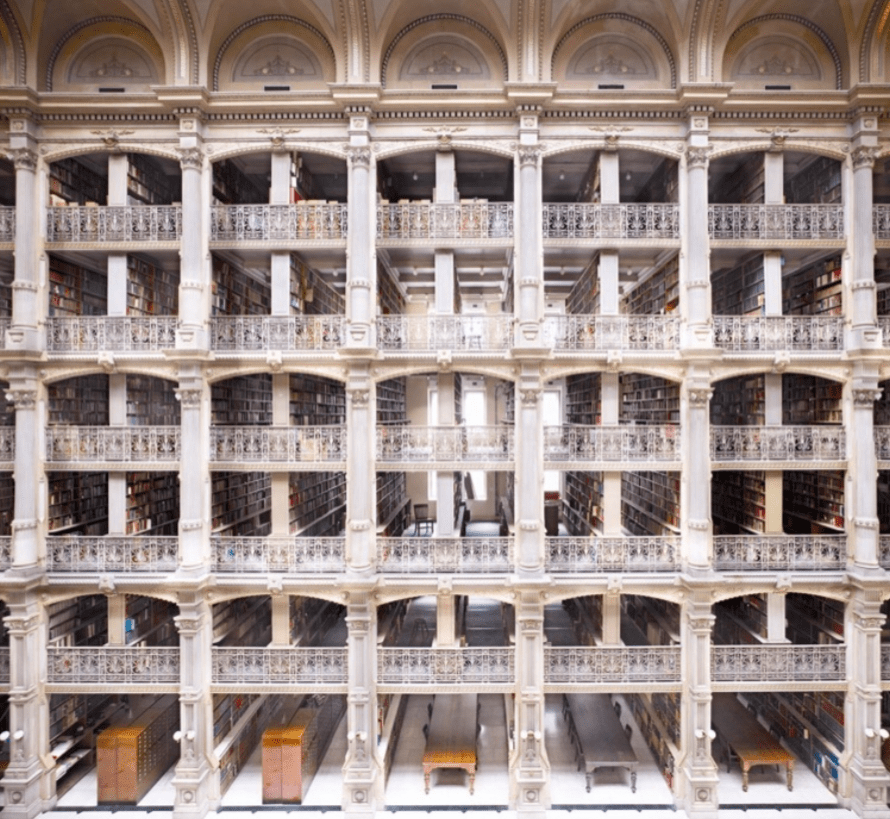
Our first great female artist is the one and only Candida Höfer. Born in 1944 in Eberswalde, Germany, Candida Höfer is a contemporary artist occupied with fine art photography, living and working in Cologne, Germany. Höfer is best known for her meticulously composed photographs, most often large in scale and filled with clear colors, of architectural interiors, such as churches, libraries, museums, hotels, palaces, concert halls, and more.
She examines the psychological impact of the design and the often disturbing relationship between the interior designated function and its actual use. Paradoxically, these most often public spaces and rooms are photographed empty, creating a certain tension due to the absence of its inhabitants.
Höfer has exhibited at major institutions such as the Kunsthalle in Basel, the Louvre in Paris, the Hermitage Museum in St.-Petersburg, the Museum of Modern Art (MoMA) in New York, or the Guggenheim Museum in Bilbao, illustrating her internationally established career as one of the most important artists and photographers of her time.[3]
For further reading on Kandida Höfer, we highly recommend the recently published (2020) Candida Höfer: Editions 1987-2020.
Next, we encounter the youngest artist from our list, Alicja Kwade. Born in 1979, the Polish-German artist lives and works in Berlin, Germany. Being born eight years after Linda Nochlin’s article mentioned above, it is no surprise to find Alicja Kwade not only in our list of The Ultimate Top 100 Modern & Contemporary Artists, but also in our article of The Most Influential Young Artists You Need To Know.
Kwade is best known for her internationally reputed oeuvre of mixed-media sculptures and large-scale installations. She continuously examines the structures that define our reality and society with these sculptures. In doing so, Alicja Kwade takes on subjects such as the continuum of time and space and philosophy, science, and cosmology.
Kwade has exhibited worldwide features in the most important private and institutional collections. Think of the Centre Pompidou in Paris, the Los Angeles County Museum of Art, or the Momok Foundation Ludwig in Vienna.[4][5]
For further reading on the young and enigmatic artist, we highly recommend the monographic publication Alicja Kwade, published by Distanz Verlag in 2017.
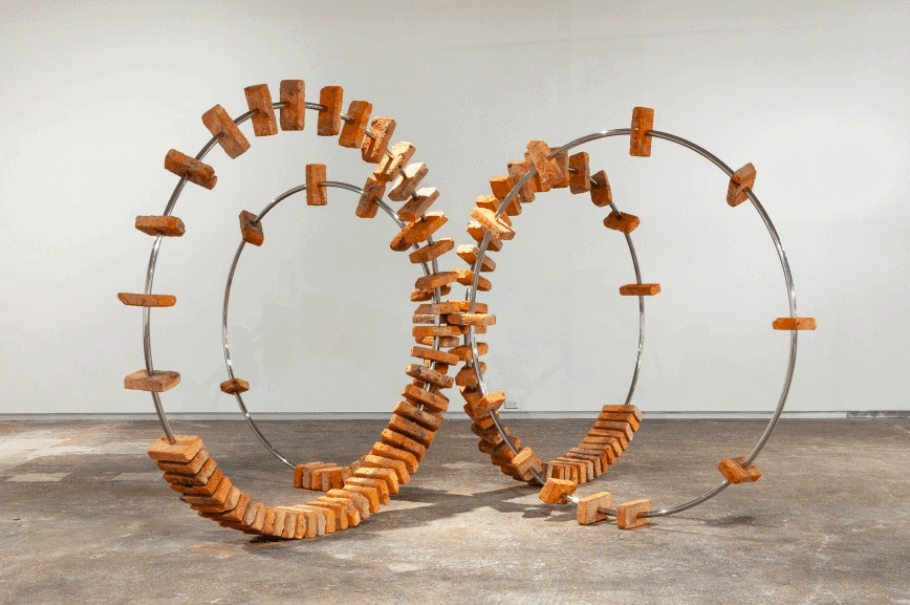
Ana Mendieta was born in 1948 in Havana, Cuba, and passed away in New York City, the United States of America, in 1985. Mendieta is a Cuban-American artist best known for her performances, videos, paintings, and sculptures, examining the relation between the earth, the human body, and identity in all its complexity.
In 1961 at the age of 12, Ana Mendieta moved to Iowa with her sister via a US asylum program during the Cuban Revolution. Her interdisciplinary oeuvre deals with violence against women, the role of the (female) body, and her identity as an immigrated US citizen, but also as a person of color, a woman, her age, and a combination of everything above. Arguably, her best-known artworks are from her ongoing Silueta series, in which she traces imprints or silhouettes of where once was a body in a natural landscape or environment.[6]
Her impressive oeuvre received worldwide recognition from the late 70s and early 80s, resulting in an exponential rise in the international contemporary art scene. Her works were showcased at the Museum of Modern Art (MoMA) in New York, the Art Institute of Chicago, the Hirshhorn Museum and Sculpture Garden in Washington, and the Whitney Museum of American Art in New York.
For further reading on Ana Mendieta, we highly recommend Ana Mendieta: A Book of Works.
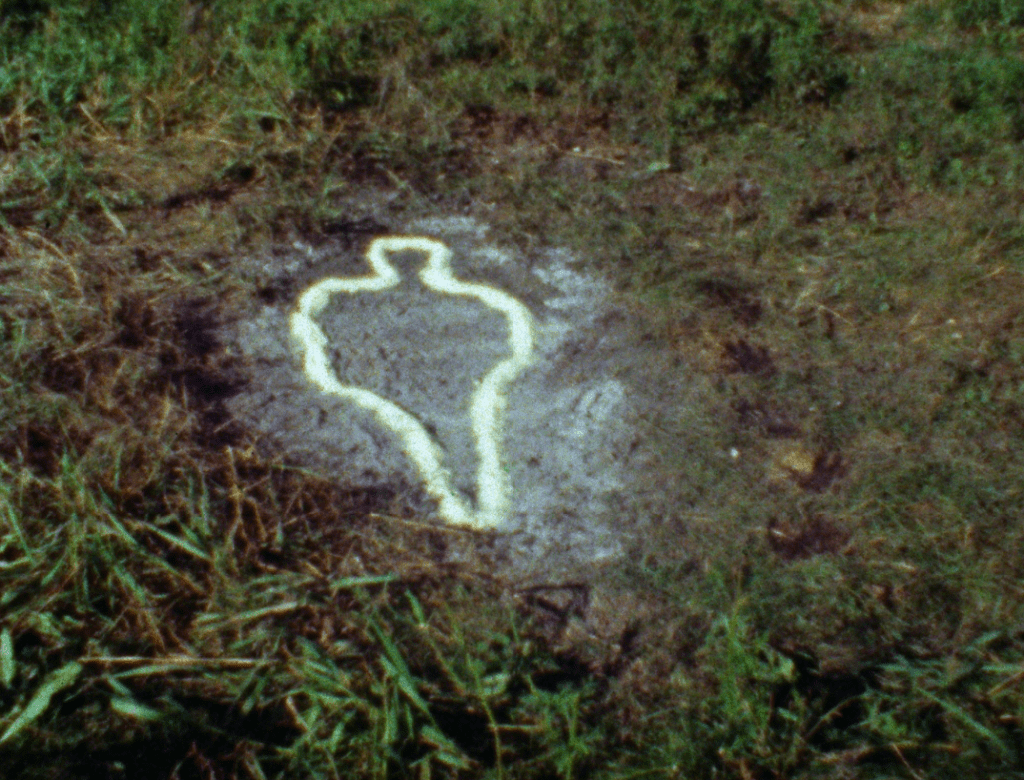
Born in 1953 in Washington D.C., Nan Goldin is a contemporary artist and one of the most influential figures of her generation, currently residing and working in New York City, the United States of America. Goldin has established an internationally reputed oeuvre with her revolutionary approach to fine art photography. She takes on deeply personal portraits, with no filter at all, from a visual point of view and in the subject matter.
During the 1970s, Goldin explores gender and the traditional conventions of normality by documenting her life and friends, giving a voice to her surroundings and different communities who fall outside of these conventions. Doing so, the American photographer addresses issues such as the war on drugs, resulting in the Prescription Addiction Intervention Now (P.A.I.N.) group, raising awareness for the decriminalization of drug users and advocating for life-saving treatments.
Goldin is represented by industry-leading art galleries and has had major retrospectives at the Whitney Museum of American Art in New York (1996) and the Centre Pompidou in Paris (2001). She has also exhibited at Tate Modern in London, the Irish Museum of Modern Art in Dublin, the Museum of Modern Art (MoMA) in New York, and the Portland Museum of Art.[7]
For further reading on the photographic and socially engaged oeuvre of Nan Goldin, we highly recommend the monographic book Nan Goldin: The Ballad of Sexual Dependency, published in 2012 by Aperture.
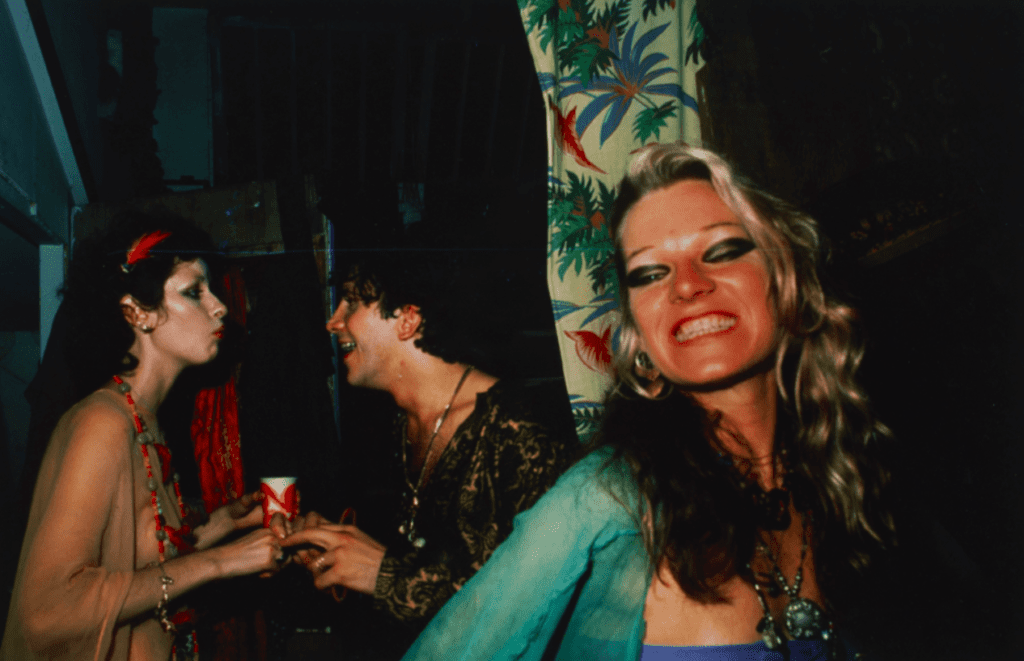
Born in 1933 in Tokyo, Japan, Yoko Ono is arguably one of the most famous artists on our list. Associated with Conceptual Art and Fluxus, Yoko Ono moved to New York in the 1950s, where she emerged onto the international art scene in the 1960s with her experimental films, music, and performances.
Strong interaction with her audience marks her interdisciplinary artistic practice. She communicated verbally or with written instructions to the public in her earliest works. The viewers were invited to participate in the performance or to contribute to a particular artwork. Think of one of her most iconic artworks, Cut Piece from 1964 (see image above), in which Ono invited people to cut away portions of her clothing.
The Japanese-American artist is very well known due to her multiple artistic collaborations with her late husband, John Lennon. Together, they bundled forces as they continued to promote world peace through art and music, as she continues to do so to this day.[8]
For further reading on Yoko Ono’s artistic oeuvre, we highly recommend Yoko Ono: To the Light published by Walther König, Köln, in 2012.
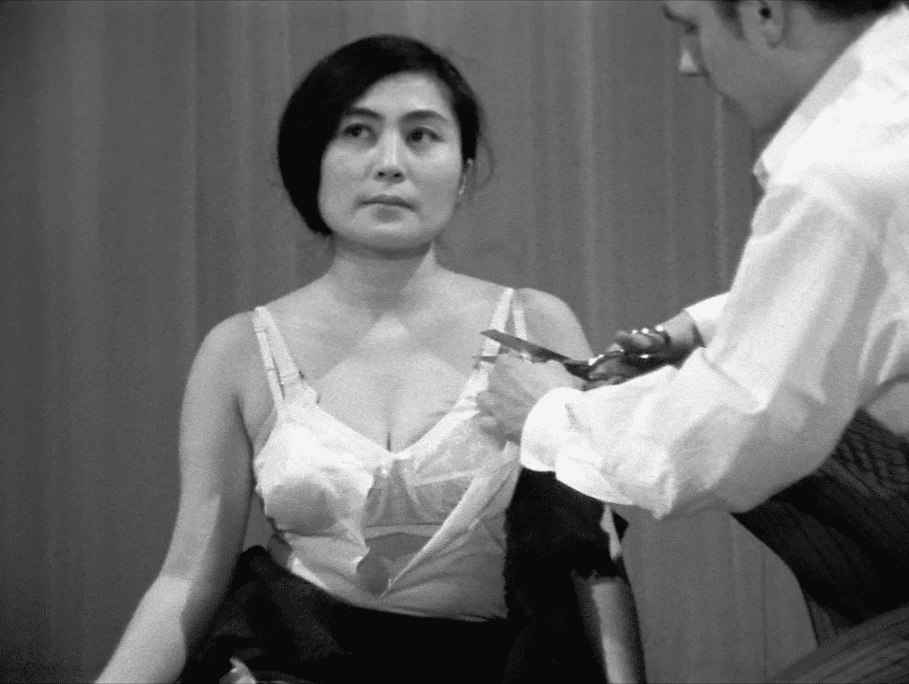
Up next, we have the charismatic artist superstar Marina Abramovic. Born in 1946 in Belgrade, Serbia, Marina Abramovic is one of the most important figures of Performance Art, pioneering performance as a form of contemporary visual art. Associated with Conceptual Art, Video Art, Body Art, and the so-called Shock Art and Endurance Art, her performances are marked by a sensational character, evoking astonishment, and incorporating the participation of the observer into her works.
Her body is both the subject as well as the medium. Since her early works in the 1970s in Belgrade, Abramovic has explored the limits of her body when it comes to physical – and mental – resistance. She confronts the viewer with actual pain, exhaustion, and danger, in search of an emotional and spiritual transformation, transcending everyday life and reality.
As her artist biography at Lisson Gallery states, Marina Abramovic was one of the very first performance artists to be included in the fold by the institutional world, an important note in the context of the article above by Linda Nochlin. As a result, she has had retrospectives at numerous major museums, such as the Louisiana Museum of Art in Copenhagen or the Bundeskunsthalle in Bonn.[9]
For further reading on the incredible body of works by Abramovic – of which some performance beggar the confound of our understanding – we highly recommend Marina Abramovic: The Artist is Present.
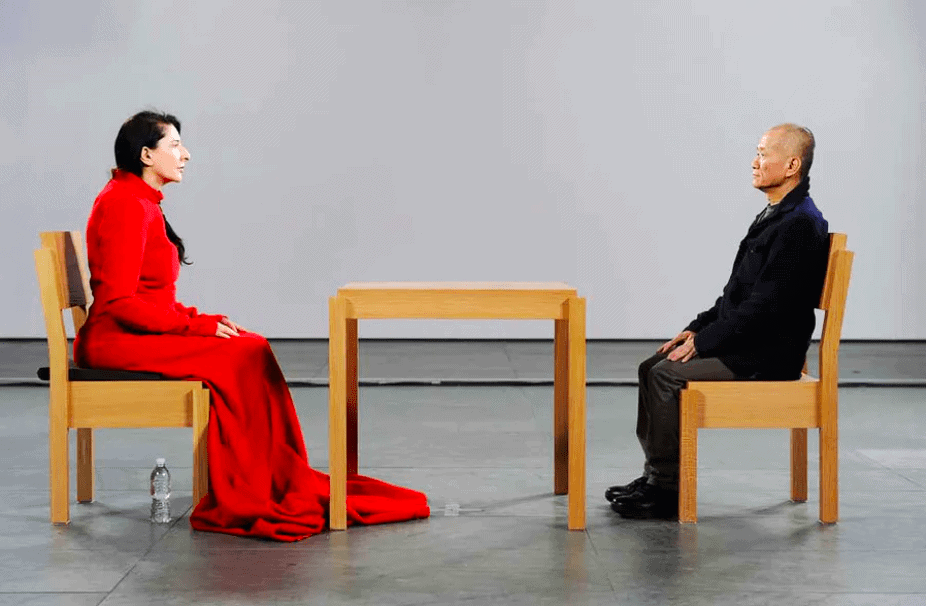
Born in 1919 in Carinthia, Austria, Maria Lassnig was a contemporary painter who passed away at 94 in 2014 in the Austrian capital, Vienna. The foundation of her internationally established career is her impressive and extensive body of work, examining the body’s physical presence. Lassnig introduced the term Körpergefühl, or body awareness, to describe more precisely the phenomenon she was capturing with her works.
After encompassing academic training, and experimental phases of Surrealism, Automatism, Art Informel, and Post-Cubism, Lassnig developed an expressive and personal style in the 1960s in Paris and New York, respectively. She recorded physiological states, using the contrast of color with her characteristic greens, pinks, and blues, combined with her unparalleled expressive lines demarcating the body and its awareness.
Lassnig drew power from being a female artist in a dominant male art world. Doing so, it became her primary subject. Finally, in the 1980s, her career received international recognition, in Europe, as she had seemed to pioneer Neo-Expressionism and a newly reinvigorated interest in figurative painting. Very soon, it became most clear Maria Lassnig is one of the most important figures in contemporary painting. As a result, Lassnig has exhibited at the Centre Pompidou in Paris, the Albertina in Vienna, the National Gallery in Prague, the Kunstmuseum in Basel, and the Stedelijk Museum in Amsterdam.[10]
For further reading on Maria Lassnig, we highly recommend the monograph Maria Lassnig: Ways of Being, published by Hirmer Publishers in 2019.
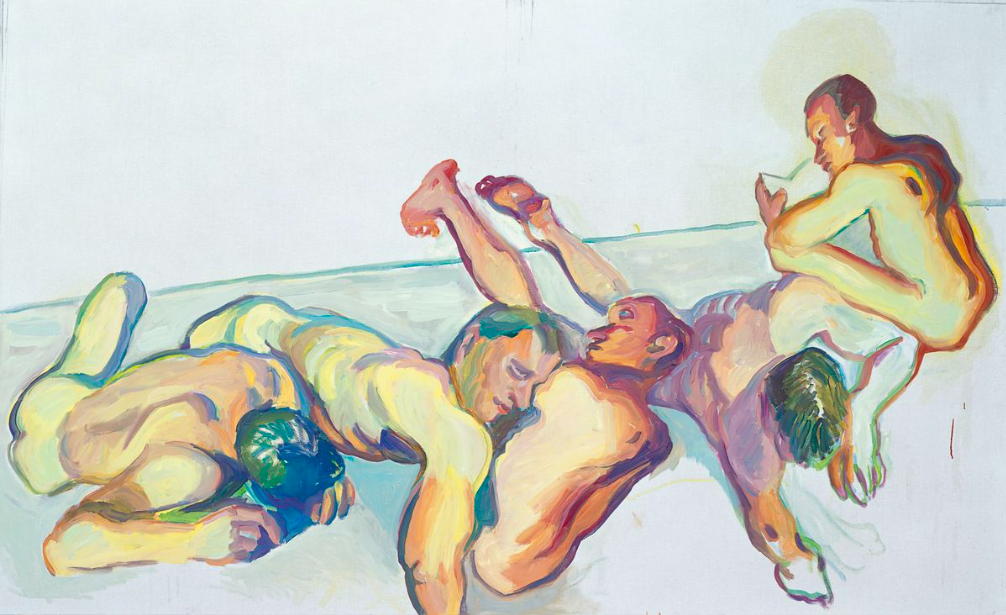
We enter the top 10 of our list with the highly-rated Jenny Holzer. Born in 1950 in Ohio, the American artist is best known for her Neo-Conceptual oeuvre of installations. She implements text across various media, including carving in marble, LED signs, public billboards, printed materials, and more. Holzer has also taken on contemporary painting in recent years, effectuating an Abstract Expressionist and almost Suprematist visual language.
Her work is strongly associated with Feminist Art, as Holzer provokes a public debate by raising awareness with her installations and public interventions for social and political inequality. Her artistic practice explores the individual and the collective experience concerning power and powerlessness, violence, and vulnerability.
Jenny Holzer is represented by the biggest mega-galleries in the world and has participated in numerous solo and group exhibitions at major institutions. Think of her contributions at Fondation Beyeler in Basel, the Whitney Museum of American Art in New York, the Museum of Contemporary Art in Chicago, the Walker Art Center in Minneapolis, the Guggenheim Museum in New York, the Dia Art Foundation in New York, Documenta 8 in Kassel, the Museum of Modern Art (MoMA) in New York, or at the Stedelijk Museum in Amsterdam.[11]
For further reading on Jenny Holzer, we highly recommend Jenny Holzer from the Phaidon Contemporary Art Series.
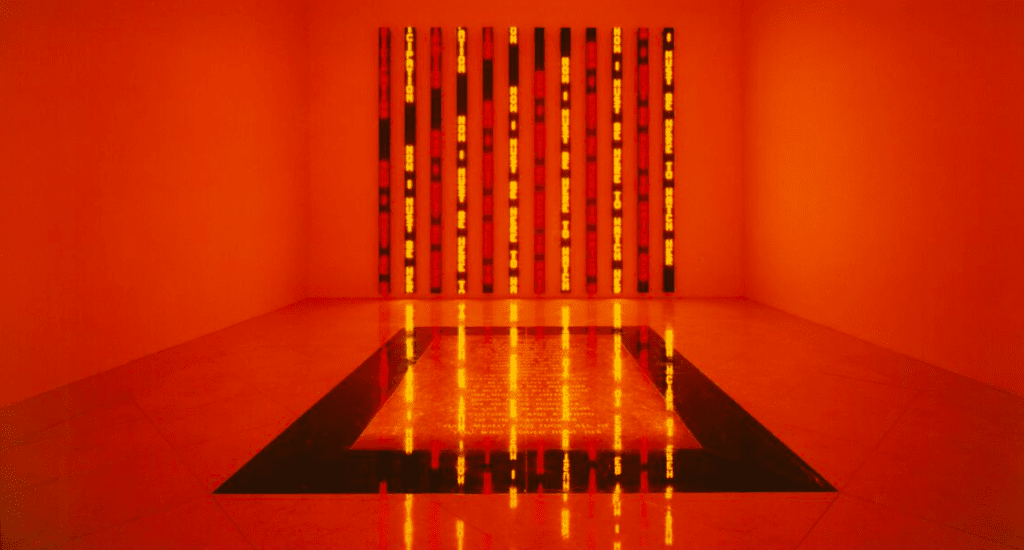
In the ninth spot, we find none other than Mona Hatoum. Born in 1952 in Beirut, Lebanon, Mona Hatoum is a British-Palestinian multimedia and installation artist, residing and working in London since 1975. She is best known for her multidisciplinary oeuvre, achieving political yet poetic work in large-scale installations, sculptures (of found objects), video work, photography, and works on paper.
Hatoum’s first works from the 1980s were predominantly focused on video and performance, exploring the notion of the body. From the 1990s and on, she has taken on installation and more, expanding her artistic practice in search of engaging artworks, confronting the viewer with conflicting emotions, encompassing fear and desire, aversion and fascination, humor and danger, power and delicateness.
The contemporary artist’s career got up to speed from the mid-1990s and onwards, resulting in participation at the 4th Istanbul Biennial, the 46th and 51st Venice Biennale, Documenta 11 and 14 in Kassel, and much more. As a result, Mona Hatoum has exhibited at major institutions such as Tate Britan in London, the Guggenheim in Bilbao, the Centre Pompidou in Paris, the Arab Museum of Modern Art in Doha, the Kunstmuseum St. Gallen in Switzerland, or the Museum of Contemporary Art Australia in Sydney.[12]
For further reading on Hatoum’s intriguing oeuvre and illustrious career, we highly recommend Mona Hatoum from the Phaidon Contemporary Art Series.
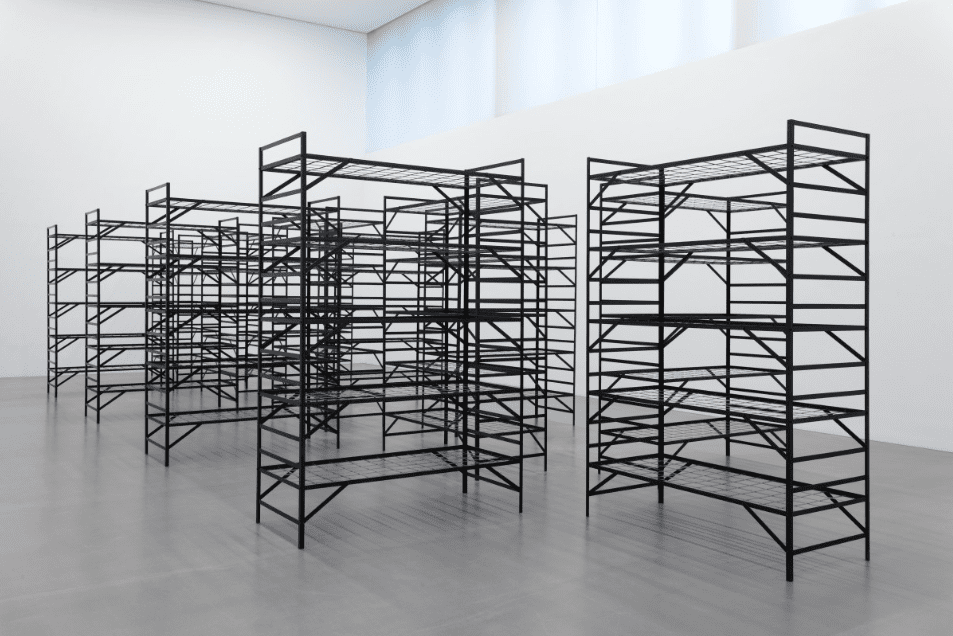
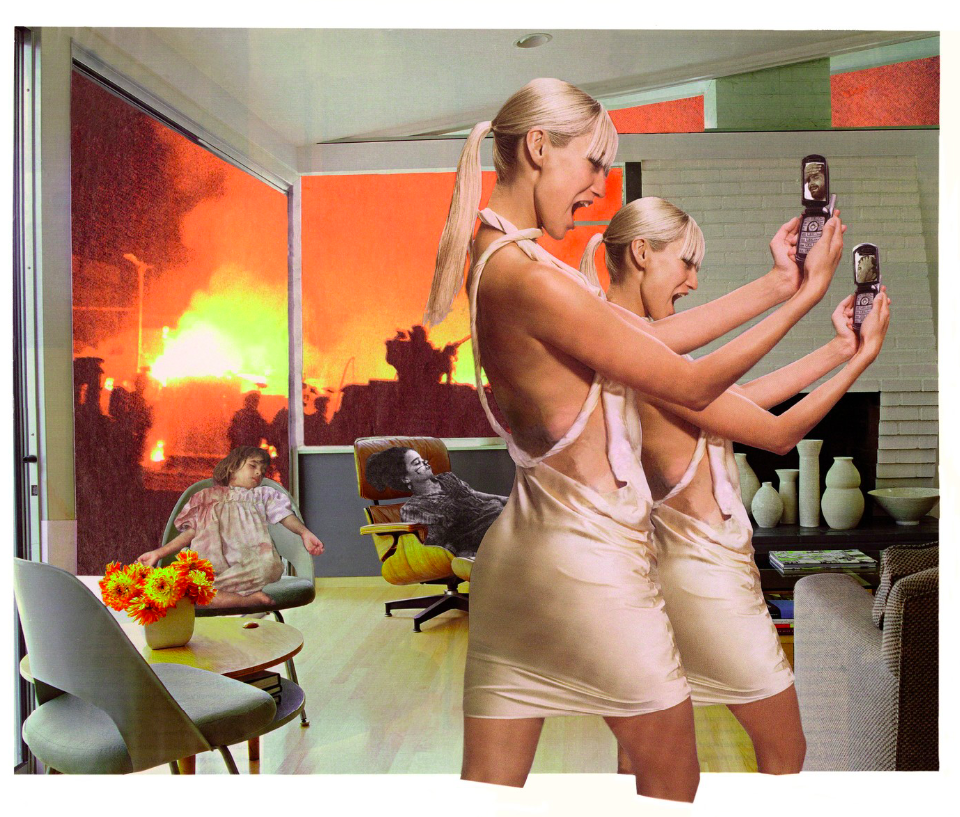
Born in 1943 in Brooklyn, Martha Rosler is an American artist best known for her photographic works or photo collages, installation artworks, and performances. Furthermore, Rosler is active as a reputed writer in arts and culture and also as an educator.
Mainly, her oeuvre focuses on politics, whether politics on war or identity. She fights social injustice and feminism, capturing the contrasts between women’s domestic lives and the horrors of war within a single photograph or photo collage. Inside, we see a domestic scene, with a woman and the role of women in society being the central subject. On the other hand, the windows of these homes do not showcase their beautiful garden or a seascape. Instead, Rosler depicts scenes of war.
Rosler has had major retrospectives at various industry-leading institutions. Think of the New Museum in New York, the International Center of Photography in New York, or a solo exhibition at the Museum of Modern Art (MoMA) in New York.[13]
For further reading on Martha Rosler, we highly recommend Martha Rosler: Irrespective published by the Yale University Press in 2018.
Born in 1948 in Bad Oldesloe, Germany, Isa Genzken is a contemporary artist living and working in Berlin. For a while now, Genzken has been considered one of Germany’s most influential artists and one of the most important artists of the modern and contemporary era.
Since the 1970s, Genzken has taken on a diverse and multidisciplinary artistic practice encompassing sculpture, photography, installation, film, drawing, and painting. Her oeuvre is rooted in Minimal Art, Conceptual Art, Assemblage Art, and punk culture. Her main aim is to confront the experience of the human condition in today’s society, discussing the restless social climate of capitalism.
Isa Genzken is represented by the biggest art galleries in the world, such as Hauser & Wirth, and has exhibited across the globe, participating in Documenta 9 and 11 in Kassel, the Venice Biennale, or shows at major institutions, including the Kunsthalle zu Kiel in Kiel, the Camden Arts Centre in London, the Museum Ludwig in Cologne, or a major retrospective at the Stedelijk Museum in Amsterdam.[14]
For further reading on Isa Genzken, we highly recommend the monographic publication Isa Genzken: Retrospective, published by the Museum of Modern Art (MoMA) in New York in 2013.
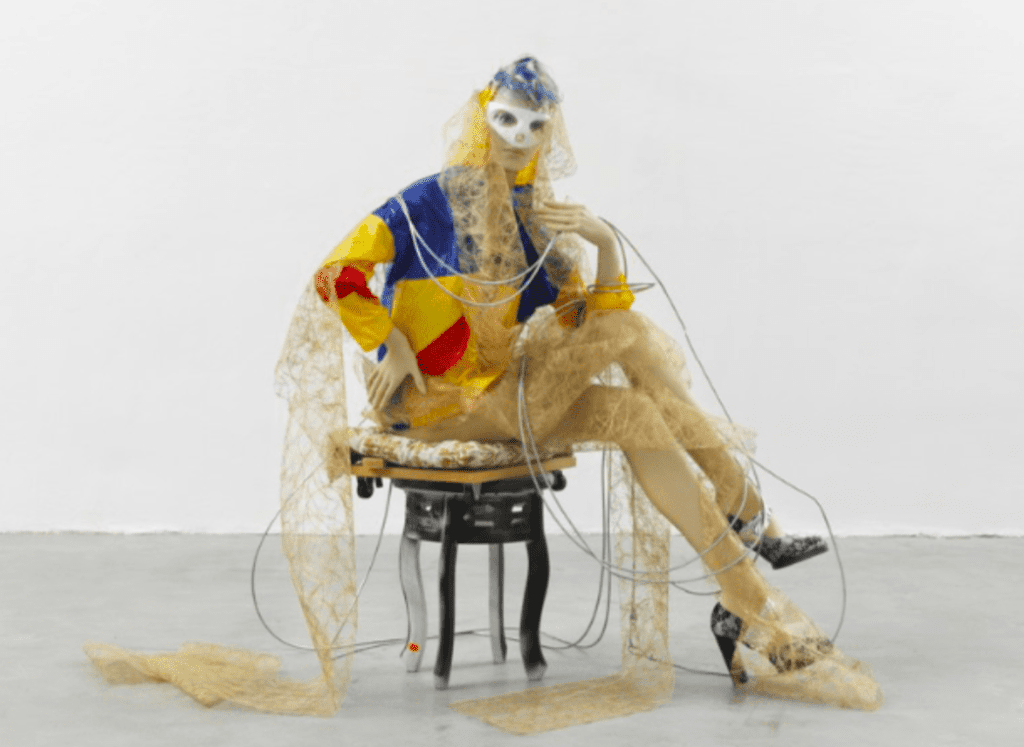
Kiki Smith, born in 1954 in Nuremberg, West Germany, is an American artist living and working in New York City and the Hudson Valley in the United States of America. She is best known since the 1980s for her multidisciplinary work, marked by a figurative visual language.
The main aim of Smith’s oeuvre is to explore embodiment and the natural world. She implements a wide array of materials, techniques, and contemporary art forms, encompassing sculpture, printmaking, drawing, and textiles. Kiki Smith depicts – in a similar manner as the aforementioned Isa Genzken – the contemporary human condition and our relationship with nature. Furthermore, she has also taken on subjects such as AIDS or gender politics throughout her internationally established career.
Kiki Smith has participated in numerous group and solo exhibitions or art events, including five Venice Biennales and solo shows at the Montreal Museum of Fine Arts, the Modern Art Museum in Fort Worth, the Museum of Contemporary Art in Los Angeles, the Hirshhorn Museum and Sculpture Garden in Washington D.C., the Carnegie Museum of Art, and more.[15]
For further reading on Kiki Smith, we highly recommend the recently published (2020) Kiki Smith.
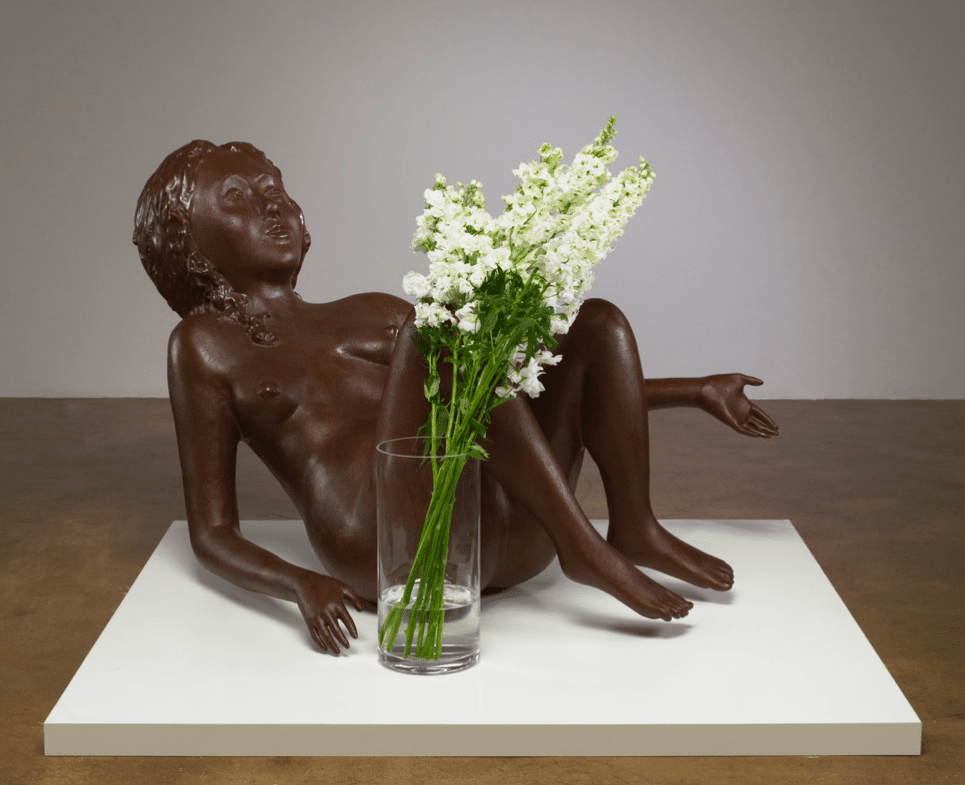
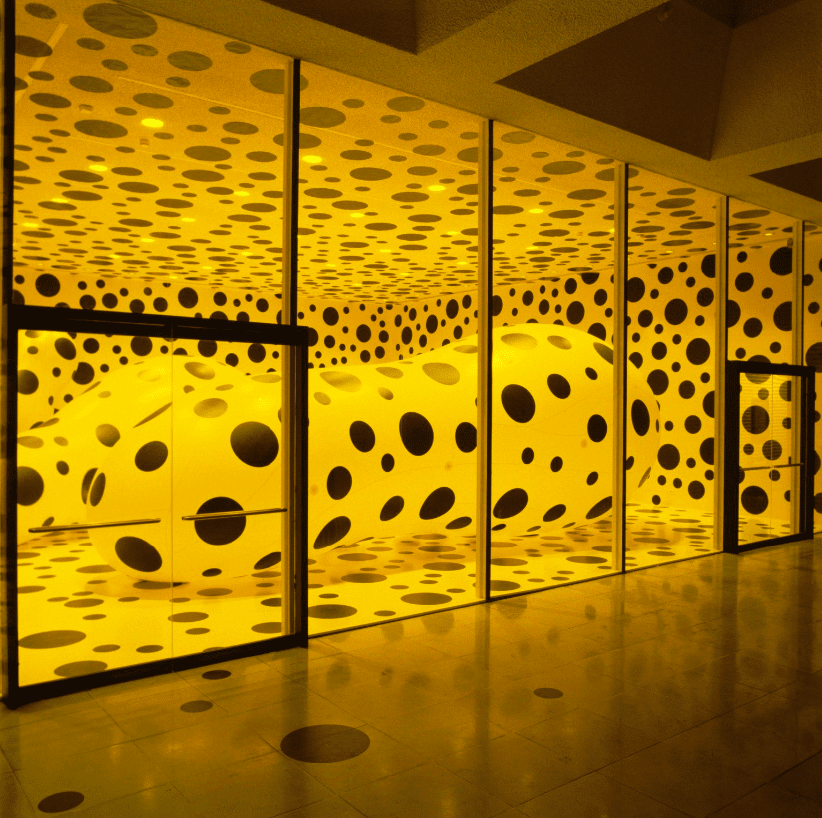
We enter the top 5 with the highly-rated artist Yayoi Kusama. Born in 1929 in Matsumoto, Japan, Yayoi Kusama is a contemporary artist who has lived and worked in New York since 1958 before returning to Japan in the 70s, where she currently resides and works in Tokyo.
The Japanese artist is best known for her dazzling infinity rooms using mirrors, infinity paintings, colorful pumpkins, and the recurrence of polka dots in any form or medium. Kusama creates sculptures, installations, contemporary paintings, films, performances, and fashion, implementing her unique visual language from hallucinations. She is strongly connected to Conceptual Art, Minimal Art, Pop Art, Performance Art, Feminist Art, and Abstract Expressionism.
As a result, the Japanese superstar is represented by industry-leading art galleries such as Victoria Miro, David Zwirner, or Gagosian. She has exhibited at major institutions, including the Center for International Contemporary Arts in New York, the Museum of Modern Art in Oxford, the Los Angeles County Museum of Art, the Museum of Modern Art (MoMA) in New York, the National Museum of Modern Art in Kyoto, or the Museum of Contemporary Art in Sydney.[16]
For further reading on Yayoi Kusama, feel free to read our extensive artist spotlight here, or, we highly recommend her retrospective monograph Yayoi Kusama: A Retrospective published in 2021.
Born in 1940 in Linz, Austria, Valie Export—better known in written text as VALIE EXPORT—is a true pioneer in film, video, and installation art. The contemporary artist established one of the most important bodies of work when it comes to Feminist Art in the post-war period, establishing herself as an iconic figure, in particular in the context of this article. The artist currently resides and works in Vienna, Austria.
She introduced herself to the international art scene in the 1960s and 1970s with her radical, groundbreaking performances and films. She explored the realms of the politics of the body and the ever-shifting relation of these politics in relation to culture, society, and the environment. She was one of the first artists to use her own body as an artistic medium, questioning the female body as a signifier and bearer of information, challenging the viewer, the male gaze, and in a quest for liberation.
Valie Export has exhibited at major international institutions, encompassing the Staatliche Kunsthalle Baden-Baden, the Neue Berliner Kunstverein, the Kunsthaus Bregenz, the Centre Pompidou in Paris, Belvedere Museum in Vienna, the Israel Museum in Jerusalem, or representing her country at the Austrian Pavilion at 1980 Venice Biennale.[17]
For further reading on VALIE EXPORT, we strongly recommend the monographic publication Valie Export: Fragments of the Imagination.
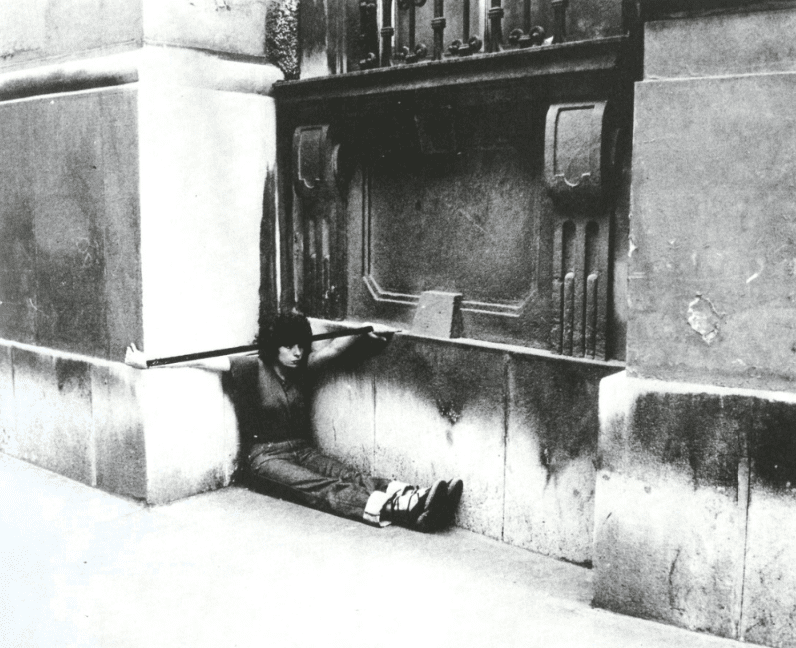
We enter the podium with none other than Rosemarie Trockel taking the bronze medal. Born in 1952 in Schwerte, Germany, Trockel is a conceptual artist best known for her multidisciplinary oeuvre in which she critiques various artistic styles, movements, and the art establishment itself.
Rosemarie Trockel reflects on the role of women in the art world – as Linda Nochlin did shortly before Trockel made her mark on the art world in the 1980s – with her paintings, drawings, sculptures, installations, and video works, but also takes on political issues, such as capitalism or mass production. She confronts us with the patriarchal dominance of the art world, characterized by an interplay of virtuosity, irony, and socio-political provocation. Her main aim is to dismantle, undermine, and destabilize various cultural categories, rules, conventions, and dogmas.
Doing so, she has exhibited at major institutions and museums, such as the Museum Ludwig in Cologne, the Museo Nacional Centre de Arte Reina Sofia in Madrid, the New Museum in New York, the Kunst- und Ausstellungshalle der Bundesrepublik Deutschland in Bonn, the Museum voor Modern Kunst in Arnhem, the Kunsthaus in Bregenz, or the Modern Museet in Malmö.[18]
For further reading on Rosemarie Trockel, we strongly recommend Rosemarie Trockel: Bodies of Work 1986-1998.
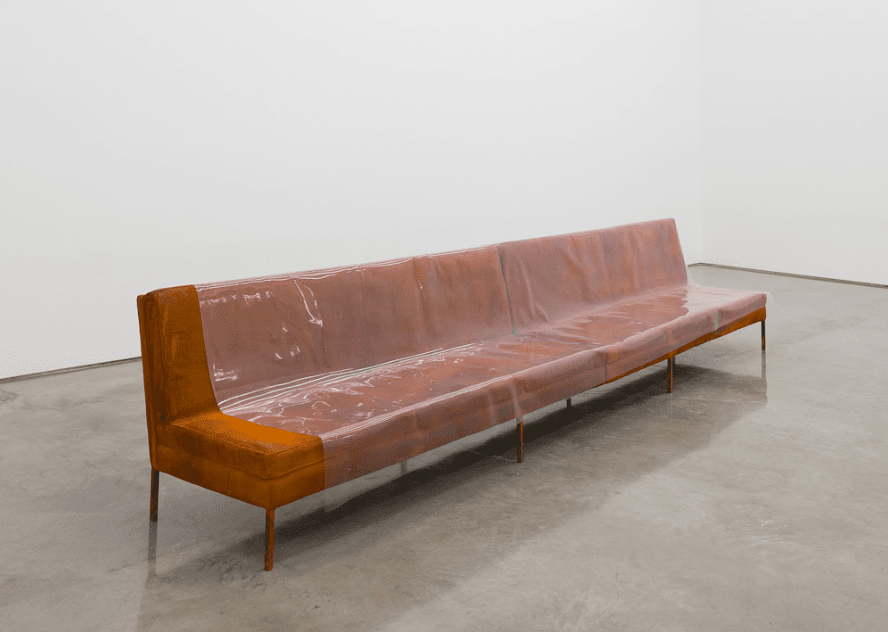
The second spot goes to the enigmatic Louise Bourgeois. Born in 1911 in Paris, France, and passed away at the age of 98 in 2010 in New York City, the United States of America, Louise Bourgeois is a truly iconic artist who was best known for her large-scale sculptures, installations, and prints. She is widely recognized as one of the most important artists of the 20th century due to her impressive career across seven decades and her even more remarkable oeuvre.
Bourgeois created sculptures using a variety of media. She combined traditional marble or bronze sculptures with everyday objects, imbuing the objects with a strong emotional value. She has produced numerous prints and drawings but also works in fabric. Arguably, Louise Bourgeois is best known for her monumental spider sculptures, which she created since the turn of the new millennium. Doing so, her oeuvre is occupied with autobiographical elements, including jealousy, violence, sexual desire, feminism, anxiety, and loneliness.
The illustrious career of Louise Bourgeois encompasses almost all major institutions. For instance, she has exhibited at the Heide Museum of Modern Art, the Museum of Contemporary Canadian Art, the Middlesbrough Institute of Modern Art, Haus der Kunst in Munich, the Modern Museet in Stockholm, the Guggenheim Museum in Bilbao, the San Francisco Museum of Modern Art, the Tel Aviv Museum of Modern Art, the Museum of Modern Art in New York, and much more. Therefore, it is no surprise to see the silver medal go to the charismatic Louise Bourgeois.[19]
For further reading, we highly recommend Robert Storr’s monograph on Louise Bourgeois Intimate Geometries: The Art and Life of Louise Bourgeois.
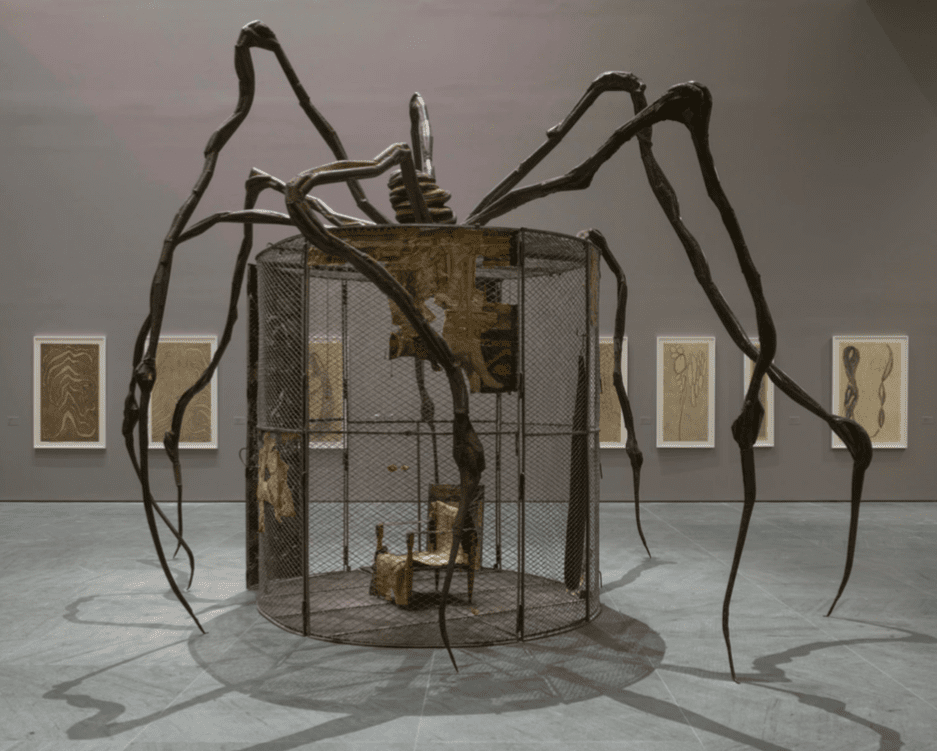
Now, we are happy to present you our gold medalist of the top 17 greatest female artists of the contemporary era: Cindy Sherman. Born in 1954 in Glen Ridge, New Jersey, Cindy Sherman is a contemporary artist residing and working in New York, the United States of America. She established international recognition in the late 1970s with her groundbreaking fine art photography, a leading figure of the so-called ‘Pictures Generation.
The two pillars her oeuvre is built on are the self-portrait and the female self. In her world-famous Untitled Film Stills series (see image above), Sherman depicts herself in various artificial contexts, presenting a stereotypical image of female characters. She creates tension between the collective psyche, which is reinforced by consumer culture, and the self of the female identity. Further, the American artist questions the manner of satire of the modern obsession with youth and beauty, which had projected onto the female identity.
As a result, Cindy Sherman has exhibited at – and is collected by – significant institutions and museums. Think of the Stedelijk Museum in Amsterdam, the Whitney Museum of American Art in New York, the Kunsthalle Basel, the Hirshhorn Museum and Sculpture Garden in Washington D.C., the San Francisco Museum of Modern Art, the Museum Boymans-van-Beuningen in Rotterdam, the Museum of Modern Art (MoMA) in New York and the Metropolitan Museum of Art in New York.[20]
For further reading on Cindy Sherman, we strongly recommend Cindy Sherman: The Completed Untitled Film.
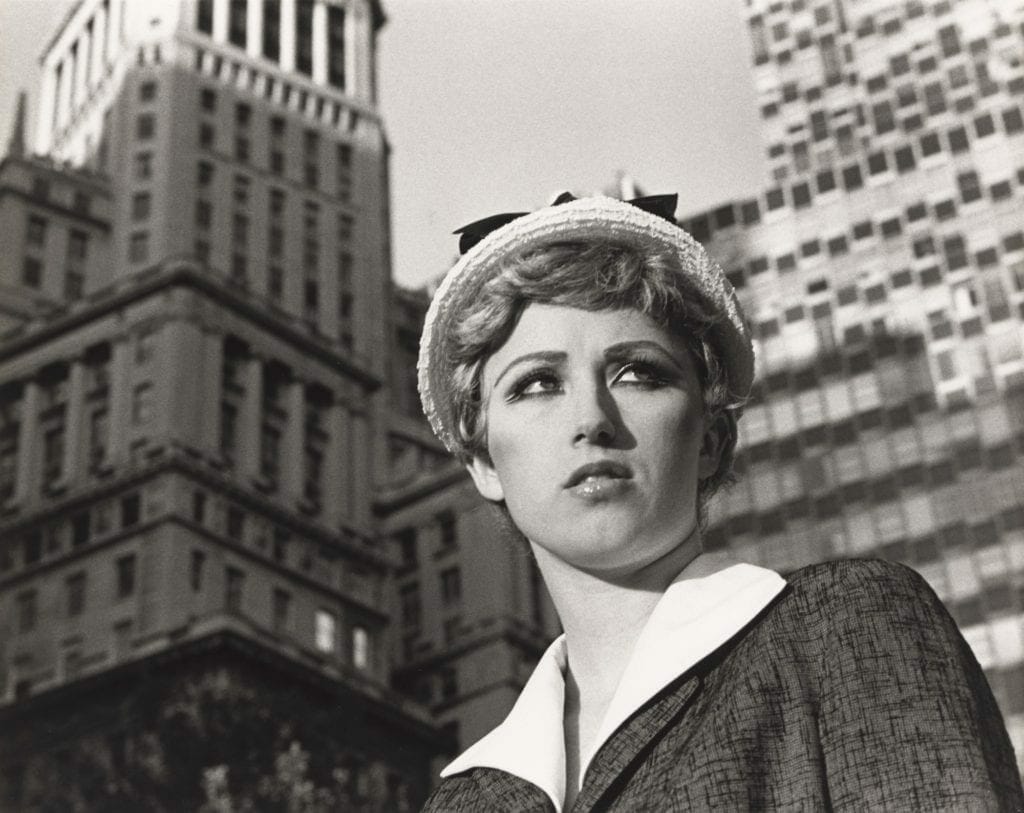
As mentioned in the introduction. The list has been assembled by an algorithm crawling objective data. However, although this is the most objective way to measure the art world and establish a ‘top list,’ it also has flaws. As a result, we permit ourselves to add or mention some significant absentees as honorable mentions, who – according to our subjective and humble opinion – should be included in this list without any doubt.
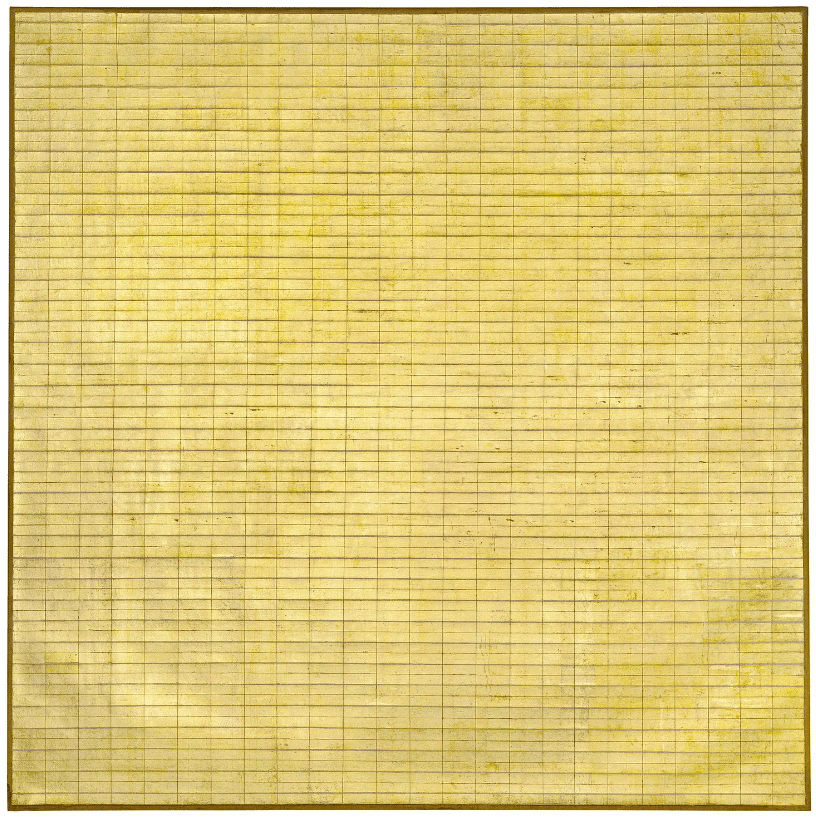
Born in 1912 in Maklin, Canada, Agnes Martin is a contemporary artist, who passed away in 2004 in Toas, the United States of America.
Agnes Martin became an internationally established artist for her radical, consistent, and minimal approach to abstract painting. Associated with Abstract Expressionism and Minimal Art, Martin implemented geometrical structures into her painterly practice. Think of motives such as ‘the grid,’ ‘blocks,’ or a muted palette minimizing the effects of line and form.
Martin has exhibited at almost all major institutions, encompassing Tate Modern, the University of Michigan Museum of Art, the Hiroshima City Museum of Contemporary Art, the Los Angeles County Museum of Art (LACMA), the Museum of Modern Art (MoMA) in New York, or the Solomon R. Guggenheim Museum in New York.
For further reading on Agnes Martin, we highly recommend Agnes Martin: Her Life and Art.

Born in 1931 in Norwood, London, Bridget Riley is a British contemporary artist living and working between Cornwall, the United Kingdom, and Vaucluse, France. She is one of the most important figures and pioneers of the Op Art movement from the 1960s.
In a similar way to the aforementioned Agnes Martin, Bridget Riley implements geometrical structures into her abstract painting. Whereas Martin opts for a Minimal approach, Riley uses solid colors and contrasts, resulting in a vibrant and dazzling optical effect. Doing so, the art movement Op Art (optical art) was established.
Bridget Riley has exhibited at major museums across the globe as one of the undoubted most influential artists of her time. She participated in Documenta IV and VI, the Venice Biennale, and is represented by industry-leading art galleries such as David Zwirner. She featured in solo and group shows at institutions such as the Museum of Modern Art (MoMA) in New York, Tate Britain, and the Scottish National Gallery.[21]
For further reading on Bridget Riley, we highly recommend Bridget Riley: Works from 1981-2015, published by David Zwirner Books.
Born in 1970 in Cambridge, Jenny Saville is a British contemporary painter living and working in Oxford, the United Kingdom. She is one of the original members of the YBA scene, the Young British Artists, among the likes of Damien Hirst and Tracey Emin.
Saville is best known for her figuratively painted body of works, internationally lauded for her characteristic Rubensesque style depicting voluptuous bodies. Saville blends Baroque with Cubism and American abstraction with photographic figuration. She is fascinated by pathological perceptions of the body. In doing so, she depicts the body as one would experience it. Often meaty and grotesque, mostly female. She tackles issues such as gender binary, the Western ideal of beauty, the individual perception of the body, obesity, and more.[22][23]
The British artist is represented by mega-galleries such as Gagosian. She has exhibited at the Museum of Kalmar in Stockholm, the Museo d’Arte Contemporanea in Rome, the Norton Museum of Art in Florida, the Kunsthaus Zürich, the Ashmolean Museum in Venice, and the Scottish National Gallery of Modern Art.
For further reading on Jenny Saville, we highly recommend Jenny Saville published by Rizoli in 2018.
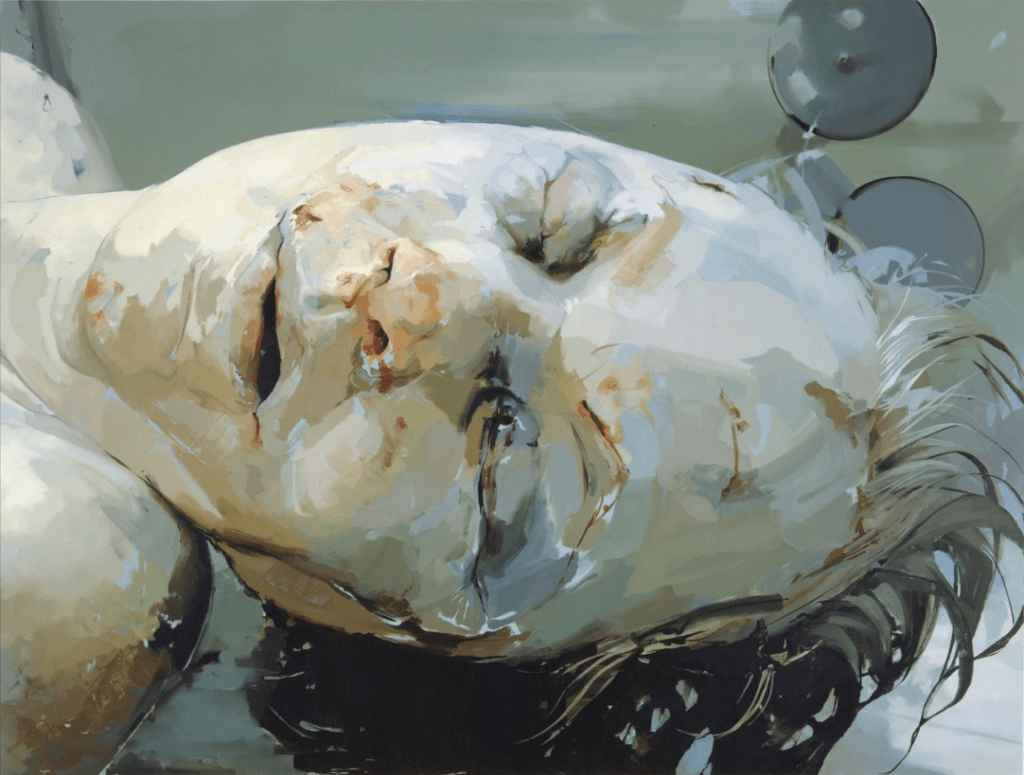
Born in 1970 in Addis Ababa, Ethiopia, Julie Mehretu is an American artist currently residing and working in New York City. She is best known for her paintings and murals, often large in scale, consisting of many layers, marks, and dynamic lines.
Her works can be seen as abstracted landscapes, using erasers, ink, pencil acrylic paint, spray paint, screen printing, and more. She combines hints of Futurism, Abstract Expressionism, calligraphy, and graffiti or street art in her eclectic tableaus, examining our urban environment’s history and sociopolitical effects. She draws inspiration from architectural plans, photographs, and city maps, which she transfers onto her canvas as a starting point to depart.
Mehretu’s works are widely collected by institutions such as the Minneapolis Institute of Art, the Museum of Modern Art (MoMA) in New York, the Brooklyn Museum, and the San Diego Museum of Art. She has exhibited at the Busan Bienniale in Korea, the Baltic Triennial in Vilnius, Documenta in Kassel, or at institutions such as the Museum of Modern Art (MoMA) in New York or Palazzo Grassi in Venice.[24]
For further reading on Julie Mehretu, we highly recommend the recently published monograph Julie Mehretu.
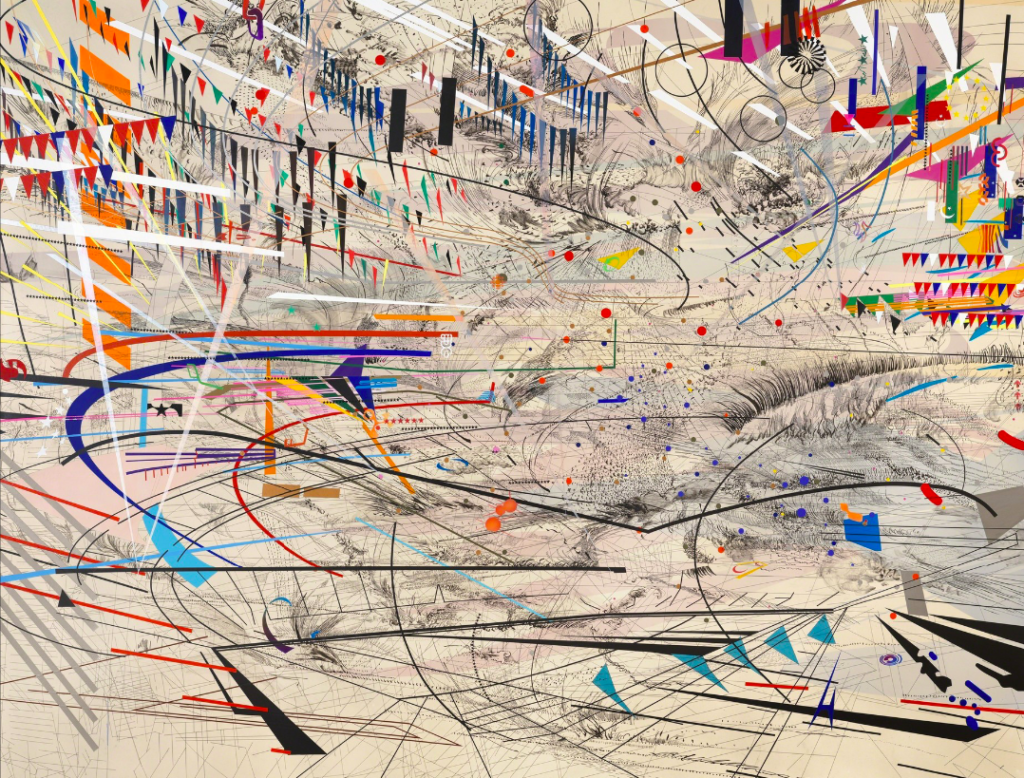
Born in 1963 in Croydon, England, Tracey Emin is a British contemporary artist residing and working in London, the United Kingdom. She is best known for her multidisciplinary practice encompassing film, neon, sculpture, installation, drawing, and even embroidery.
As the aforementioned Jenny Saville, Tracey Emin is part of the YBA, the Young British Artists scene. She distinguished herself with her poetic yet confessional artistic practice, marked by a conceptual mode but also tenderness, sincerity, and above all, audacity. She implements utmost personal and intimate experiences into her publicly artistic oeuvre. Emin is often called the ‘Enfant Terrible’ of the YBA generation. She provokes and shocks her audience with brutal honesty and the raw and unfiltered she exposes herself to the (art) world.
The best way to explain this notion is with two of her most iconic artworks. The first, Everyone I have Ever Slept With 1963–1995 from 1995, consisted of a tent with all the names of actual people she slept with. The second is My Bed from 1999, where she exhibited her bed as a readymade installation, untouched and unmade, after several weeks of drinking, smoking, eating, sleeping, and sexual intercourse. As a result, the bed contained traces of blood, underwear, condoms, and other undetermined stains.
Emin has been exhibited at and is collected by the More Art Museum, the Whitney Museum of American Art, the Stedelijk Museum in Amsterdam, the Tate in London, and the Museum of Modern Art (MoMA) in New York.[25]
For further reading on Tracey Emin, we highly recommend the monographic publication Tracey Emin: Works 2007-2017.
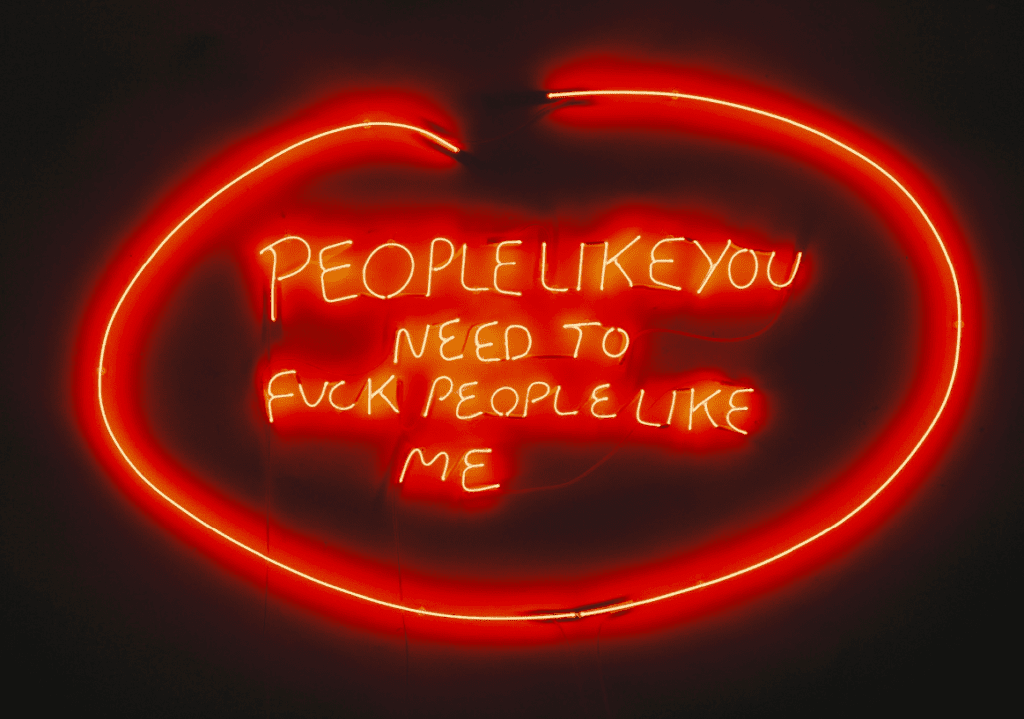
Born in 1953 in Cape Town, South Africa, Marlene Dumas is a contemporary painter living and working in Amsterdam, The Netherlands. She is best known for her characteristic figurative language, painting figures sensually and uniquely.
Dumas takes on thought-provoking subjects after a period of maniacally collecting images from which she draws inspiration. She merges political issues with personal experiences, dissolving the distinction and internalizing collective issues. She implements art historical references in her quest for second-hand images evoking first-hand reactions. Marlene Dumas tackles subjects such as segregation, apartheid, politics, war, cultural processes of objectification, and more.[26]
Marlene Dumas has exhibited at major art galleries and institutions, such as Zeno X Gallery, David Zwirner, the Stedelijk Museum in Amsterdam, the Museum of Contemporary Art in Los Angeles, the Museum of Modern Art (MoMA) in New York, the Institute of Contemporary Art in Boston, the name just a few.
For further reading on Marlene Dumas, we highly recommend Marlene Dumas: The Image as Burden.
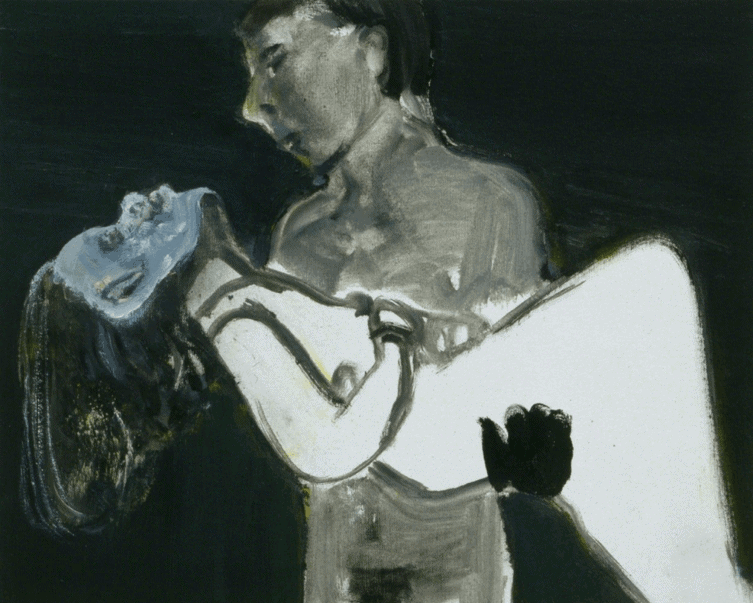
We conclude this article on the greatest female artists of the contemporary era with Marlene Dumas. As a result, I would like to invite you to sit back and enjoy one of my absolute favorite artist documentaries titled, Marlene Dumas: Miss Interpreted. Feel free to watch the entire film online via our list article with the best art documentaries to watch now (with many more great picks!).
Notes:
[1] Linda Nochlin, “Why Have There Been No Great Women Artists” in ArtNews (January, 1971).
[2] Artfacts, Home of the Artist Ranking at https://artfacts.net consulted 1/12/2021.
[3] Sean Kelly, Candida Höfer at https://www.skny.com/artists/candida-hofer#13 consulted 1/12/2021.
[4] 303 Gallery, Alicja Kwade at https://www.303gallery.com/artists/alicja-kwade/biography consulted 18/09/2020.
[5] Artsy, Alicja Kwade at https://www.artsy.net/artist/alicja-kwade consulted 18/09/2020.
[6] MoMA, Ana Mendieta at https://www.moma.org/artists/3924 consulted 1/12/2021.
[7] Marian Goodman Gallery, Nan Goldin at https://www.mariangoodman.com/artists/44-nan-goldin/ consulted 1/12/2021.
[8] MoMA, Yoko Ono at https://www.moma.org/artists/4410 consulted 1/12/2021.
[9] Lisson Gallery, Marina Abramovic at https://www.lissongallery.com/artists/marina-abramovic consulted 1/12/2021.
[10] Hauser & Wirth, Maria Lassnig at https://www.hauserwirth.com/artists/2795-maria-lassnig consulted 1/12/2021.
[11] Hauser & Wirth, Jenny Holzer at https://www.hauserwirth.com/artists/2857-jenny-holzer consulted 1/12/2021.
[12] White Cube, Mona Hatoum at https://whitecube.com/artists/artist/mona_hatoum/ consulted 2/12/2021.
[13] Artnet, Martha Rosler at http://www.artnet.com/artists/martha-rosler/biography consulted 2/12/2021.
[14] Hauser & Wirth, Isa Genzken at https://www.hauserwirth.com/artists/2784-isa-genzken consulted 2/12/2021.
[15] Pace Gallery, Kiki Smith at https://www.pacegallery.com/artists/kiki-smith/ consulted 2/12/2021.
[16] Artsy, Yayoi Kusama at https://www.artsy.net/artist/yayoi-kusama consulted 2/12/2021.
[17] Thaddaeus Ropac, Valie Export at https://ropac.net/artists/41-valie-export/ consulted 2/12/2021.
[18] Sprüth Magers, Rosemarie Trockel at https://spruethmagers.com/artists/rosemarie-trockel/ consulted 2/12/2021.
[19] Xavier Hufkens, Louise Bourgeois at https://www.xavierhufkens.com/artists/louise-bourgeois consulted 2/12/2021.
[20] Hauser & Wirth, Cindy Sherman at https://www.hauserwirth.com/artists/31810-cindy-sherman consulted 2/12/2021.
[21] Artsy, Bridget Riley at https://www.artsy.net/artist/bridget-riley consulted 10/12/2021.
[22] Artsy, Jenny Saville at https://www.artsy.net/artist/jenny-saville consulted 14/12/2020.
[23] Julien Delagrange, Apologia. Kortrijk: Contemporary Art Issue, 2021.
[24] Artsy, Julie Mehretu at https://www.artsy.net/artist/julie-mehretu consulted 10/12/2021.
[25] Artsy, Tracey Emin at https://www.artsy.net/artist/tracey-emin consulted 10/12/2021.
[26] Zeno X Gallery, Marlene Dumas at http://www.zeno-x.com/artists/MD/marlene_dumas_bio.html consulted 23/03/2021.
Last Updated on August 1, 2023

A Studio Visit During the La BIBI Residency
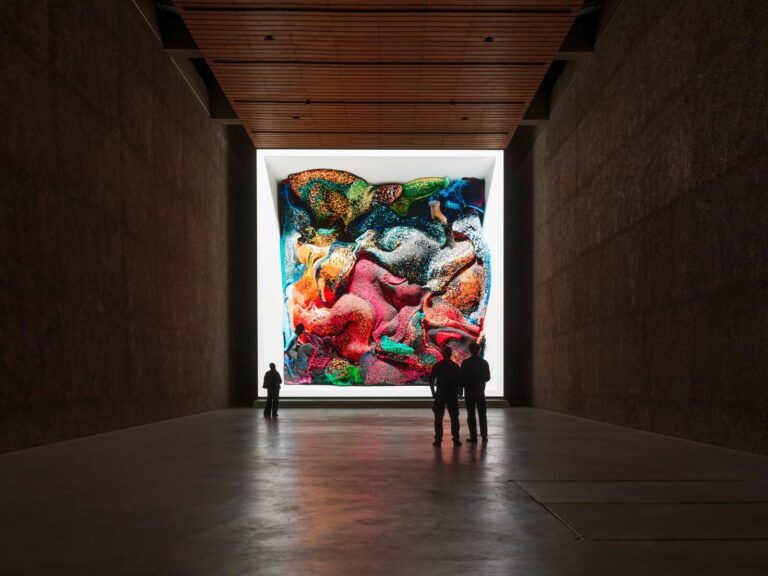
A Reasoned Anthology